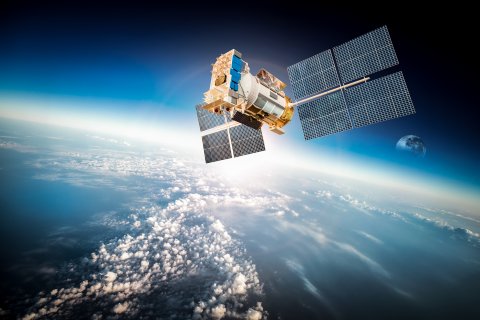Today the number of satellites in Space is enormous; therefore their reliable and long-lasting service life becomes a topical issue. Even small meteorites and pieces of space debris are dangerous for satellites. Scientists of South Ural State University are working on development of unique composite panels for protecting space objects from meteorites.
Ceramic-and-polymeric composites for protection from micro asteroids
By various assessments, there are more than a thousand of active satellites positioned on the Earth’s orbit at the present time. Also, there are more than ten thousand of objects that have been launched before, part of which has already become space debris. Velocity in space can make even small asteroids and pieces of space debris cause dangerous damage to working satellites. In this regard, protection of orbital objects from micro asteroids and space debris became a topical issue of the modern space industry. Within Project 5-100, one of the areas for research is protection of the objects from asteroids. SUSU scientists under leadership of Professor Sergey Sapozhnikov are developing unique composite panels in order to protect various objects from impact damage. Within this work, students also study the possibility to create such panels for protection of space objects.
Ekaterina Shchurova, a master’s degree student from SUSU Polytechnic Institute’s Faculty of Aerospace Engineering, is researching new materials in order to create protective screens for space satellites. An obvious requirement to such screens is light weight at sufficient resistance to impacts. Specificity of the screens’ operation is the specificity of Space itself: vacuum, rapid changes of temperature and radiation.
“The problem of all protective screens that today are intended for space facilities is in the fact, that they as a rule are produced from metals and have multi-layer hard structure, just like armored vehicles; therefore they are massive. Damage of such screen remains during the entire period left for a satellite’s operation, as repair of such protection in Space is unlikely. Our task is to develop protective screens of lighter weight. Solution lies in using ceramics. Nevertheless, ceramic plates are fragile material. After occurrence of first cracks, their operability is practically lost. Therefore another solution was proposed: the use of a composite based on ceramic particles and a matrix made of viscous material, a polymer,” explains Ekaterina Shchurova.

The necessity of theoretical calculations.
As we know, the speed of bullets and missiles of the existing weapon systems is several times slower compared to space speeds. In the world, there are single prototypes of weapons which allow accelerating impact object with multiply faster speeds. Therefore, the only available method to check all our hypotheses is calculation and, first of all, computer simulation.
“Nevertheless, computer simulation of destruction for homogenous material is greatly different from such simulation for composite structures, particularly if so-called microsimulation is used. In this case, we need to describe each ceramic particle of the composite separately, and the size of such particles is around one millimeter. Accordingly, there are millions of such particles in a protective panel, and it requires a lot of computer resources and causes problems in calculations,” explains Ekaterina.
Nowadays SUSU has the possibility to perform such calculations: the software for application of numerical calculation methods, and the university’s supercomputer equipment; only several enterprises in the CIS countries have such equipment for their disposal.
“Our calculations are aimed at both selecting the sizes of ceramic particles and their volume share in a composite and describing mechanical properties of matrix’s materials and these particles.”

From theoretical calculations to experimental tests
In many aspects, Space remains poorly studied. On Earth, space speeds are not observed in macroworld objects, therefore there is practically no authentic data about mechanical properties of materials during impacts at such speeds. But these properties should be used in computer calculations.
“When calculating impact phenomena, so-called phenomenological models of materials are frequently used; many empirical indicators are used in them. Our task is to select the more adequate model of material and its parameters. Such selection has to be done by comparison of fracture patterns obtained by calculations or during experiments. At a first approximation, we are planning to carry out experiments at ordinary earth speeds; then we will have to compare our calculations with photos of penetrations through space objects, published in articles,” says Ekaterina Shchurova.
Some results of the research are planned to be published in Lecture Notes in Mechanical Engineering journal, which is included in Scopus database.
The research of Ekaterina Shchurova, targeted at solving such topical problem as protecting space objects from impacts of micro asteroids and space debris, was awarded with grant in the Forward to Discoveries contest, held at SUSU within Project 5-100.




